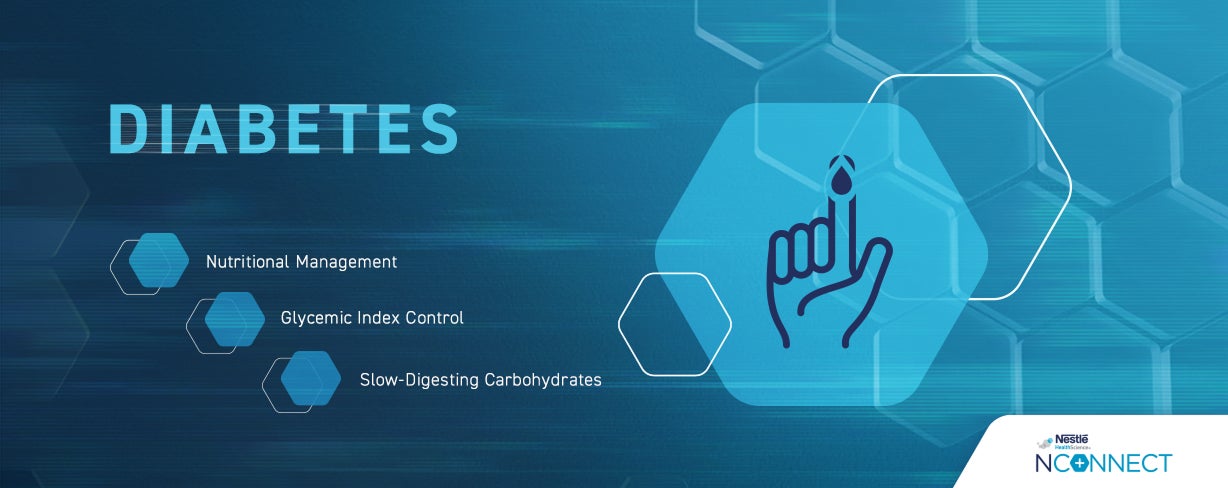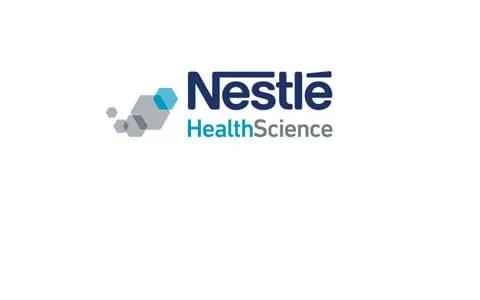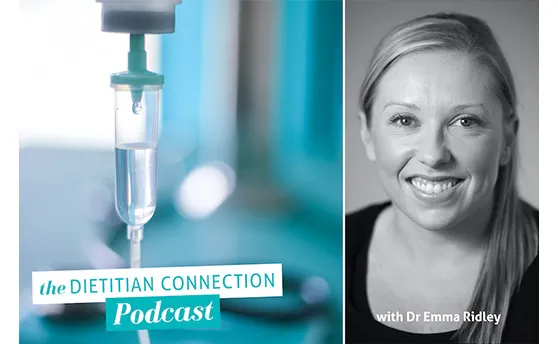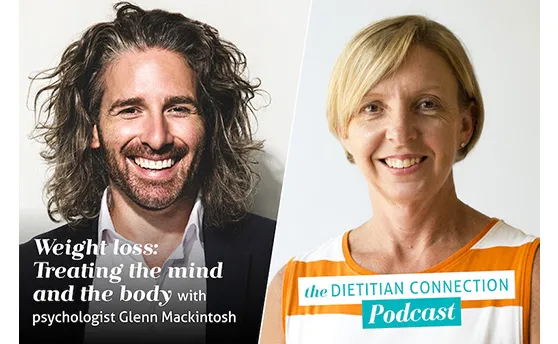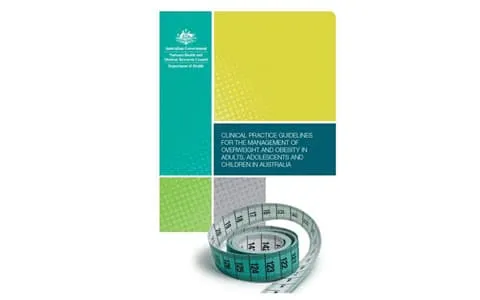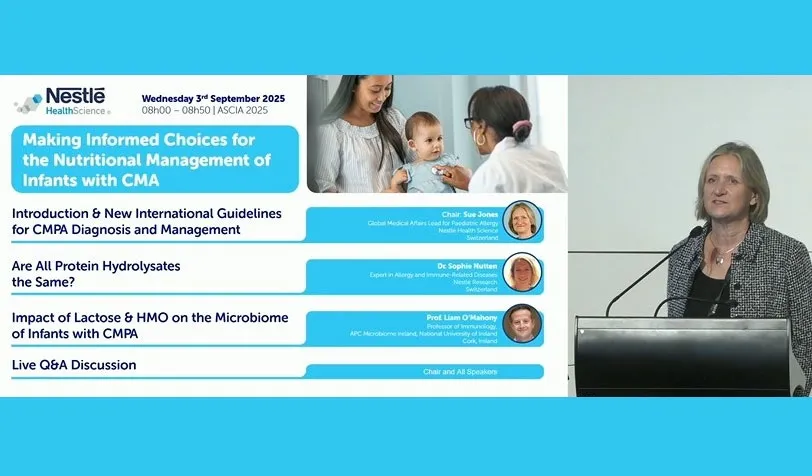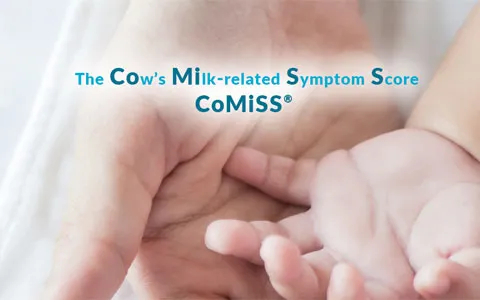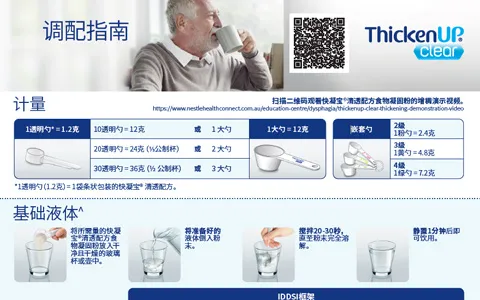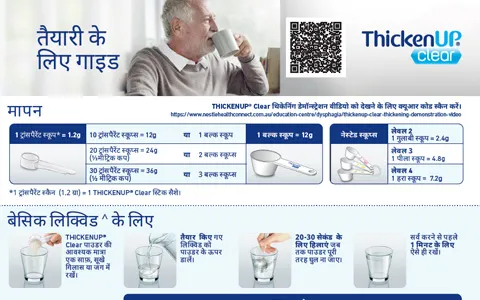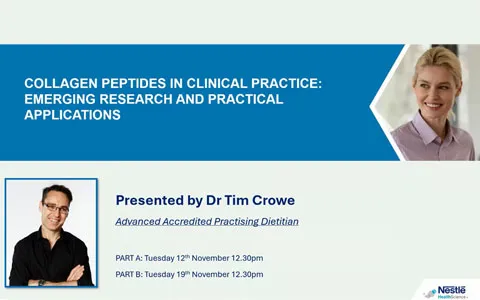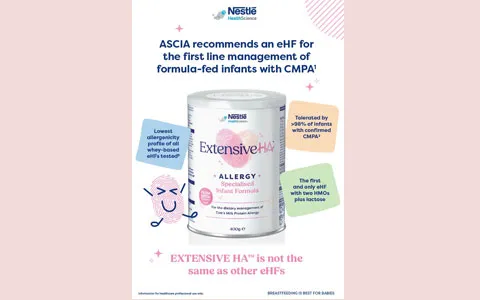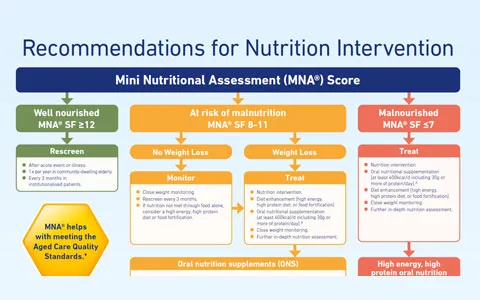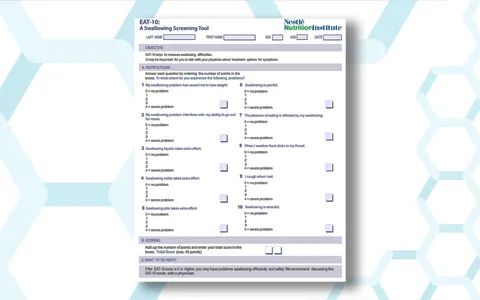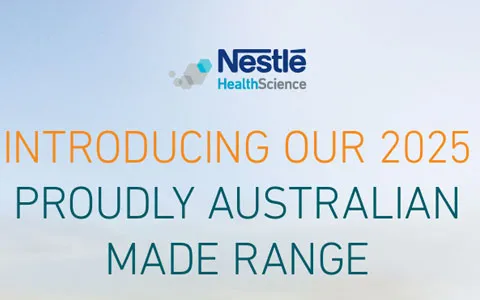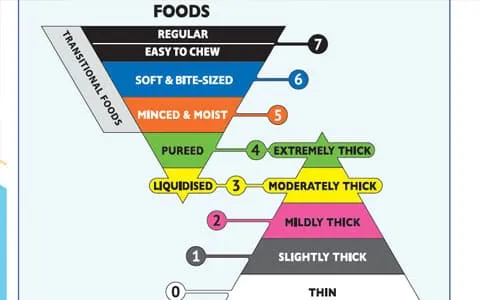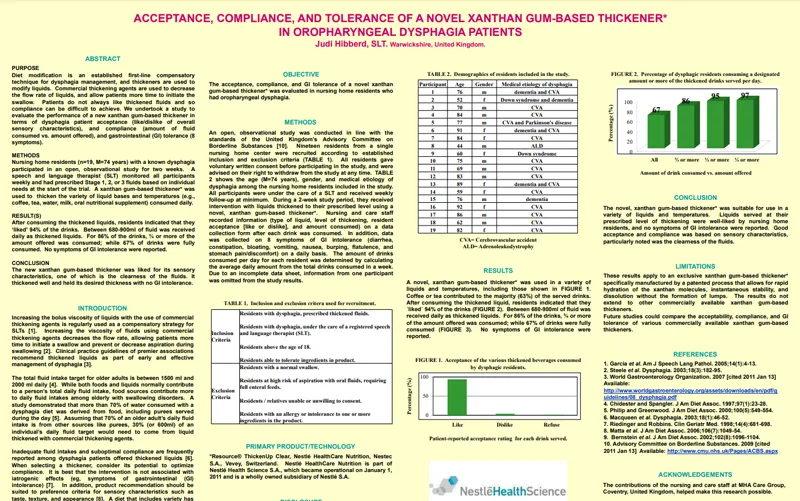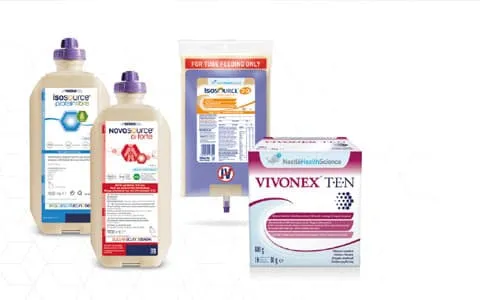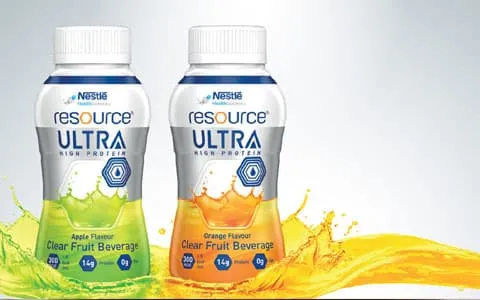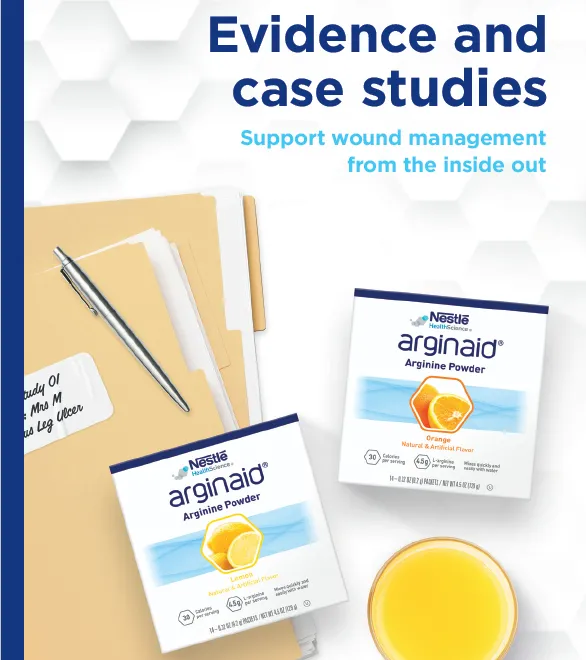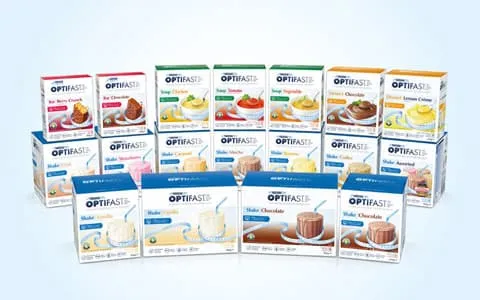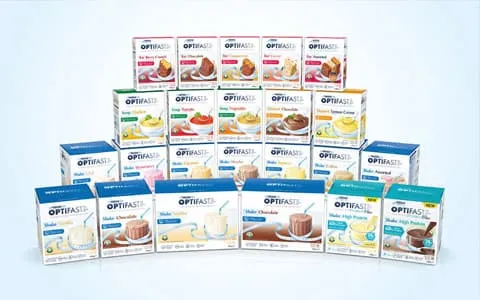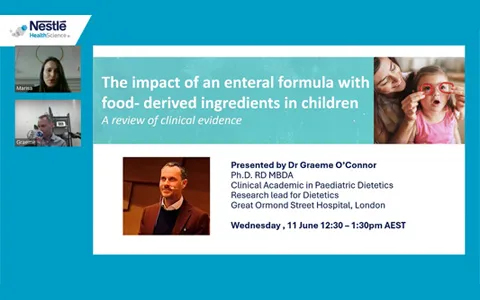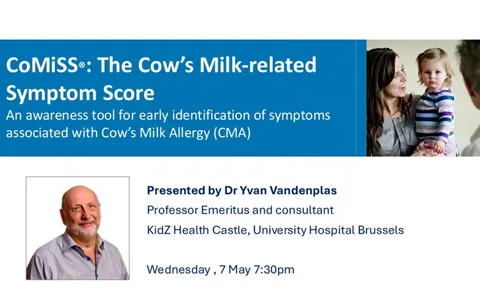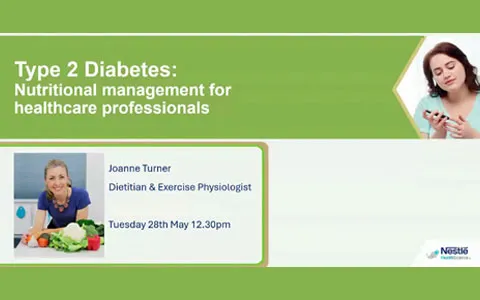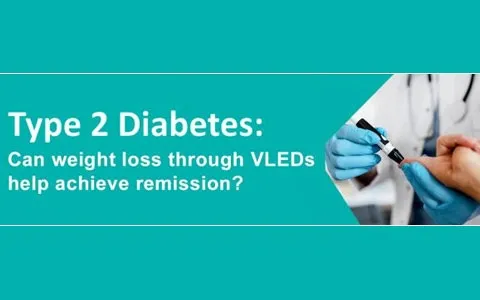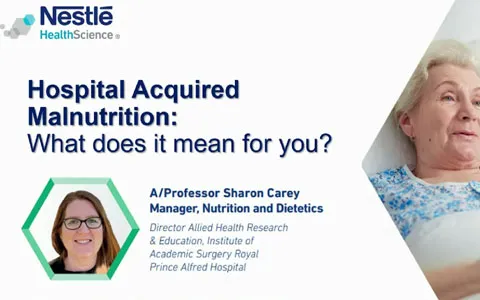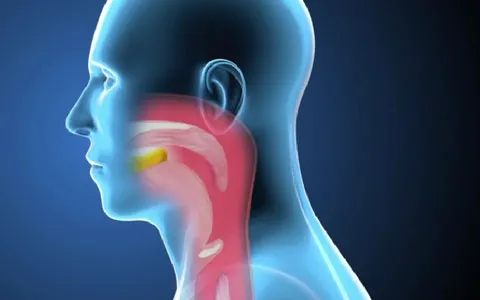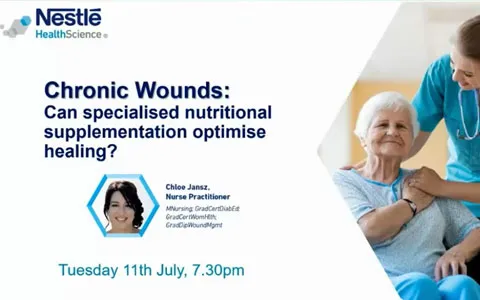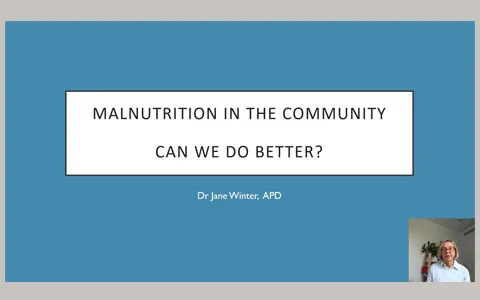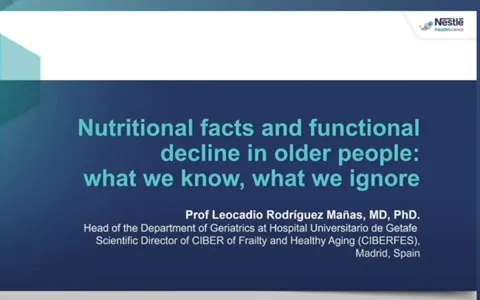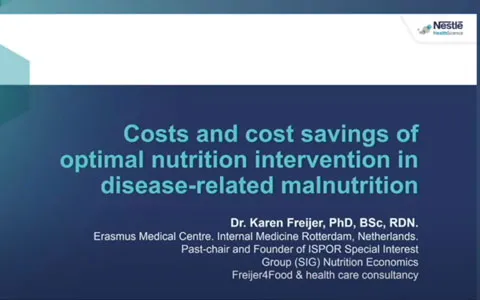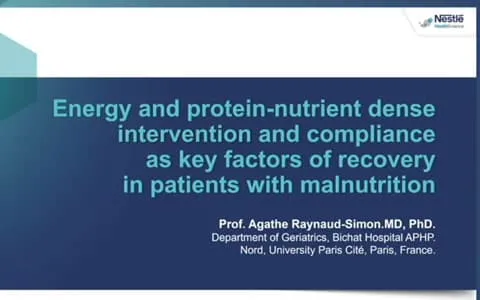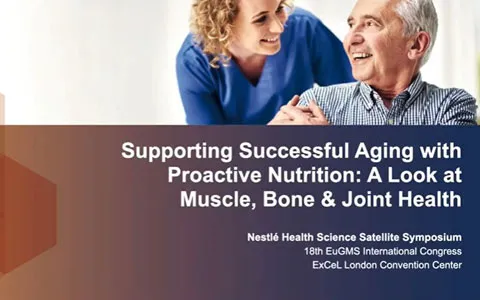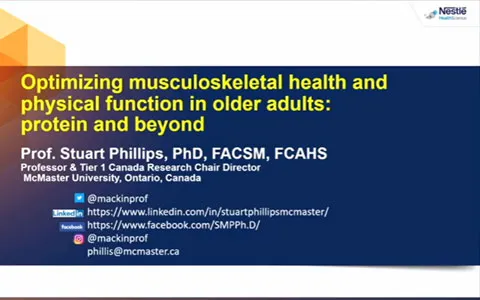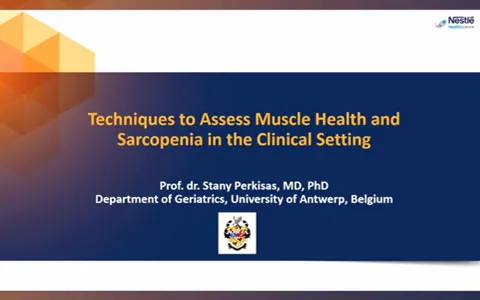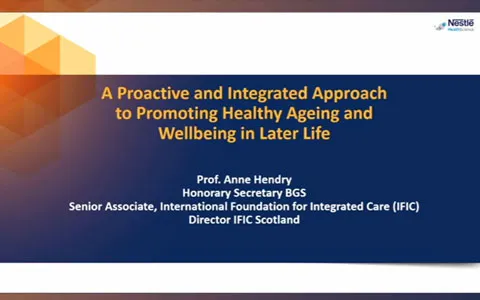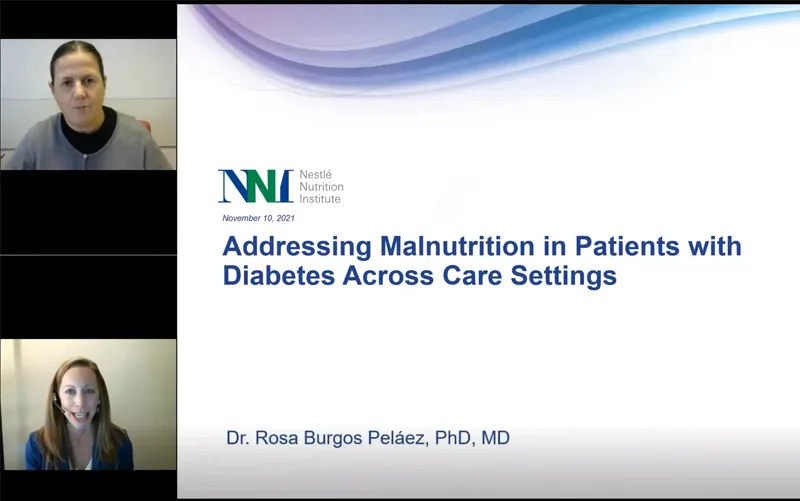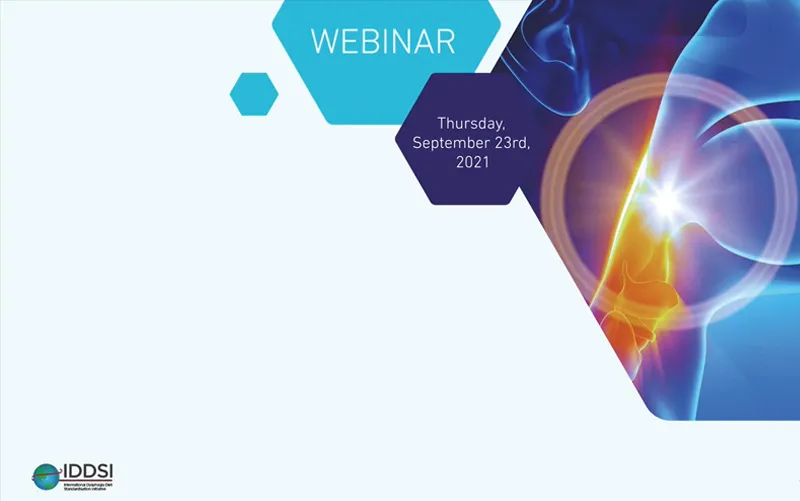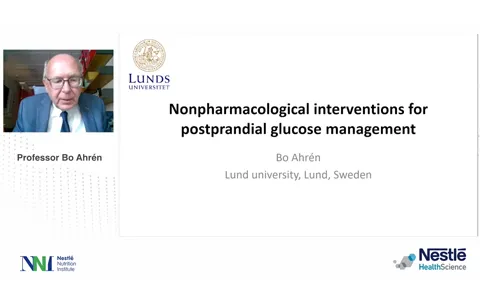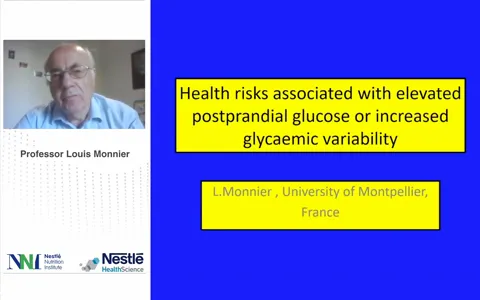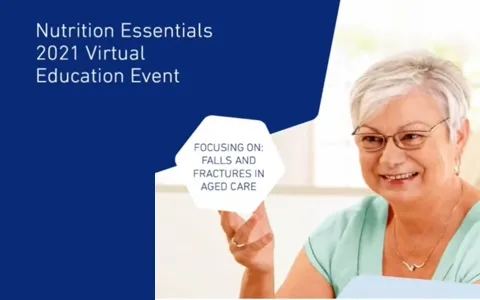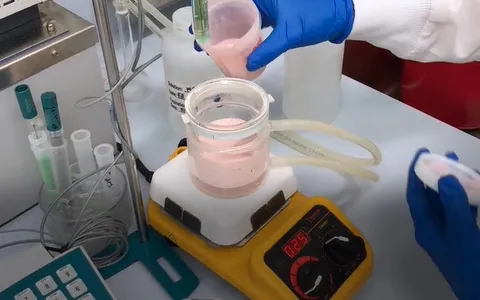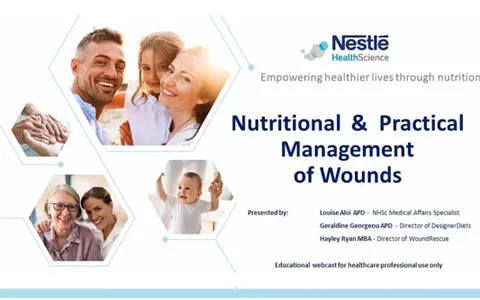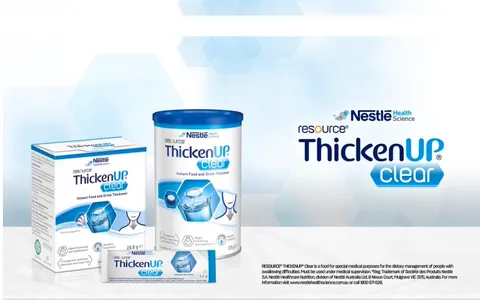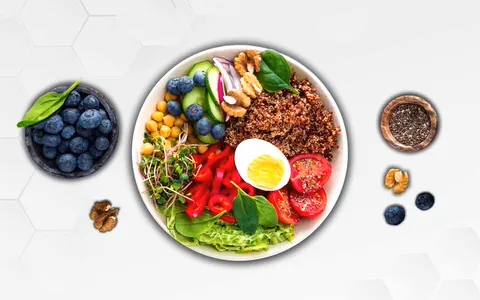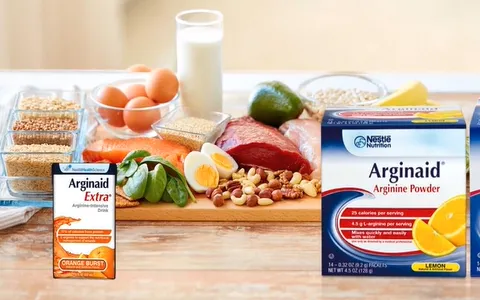Diabetes
Highlight of the month
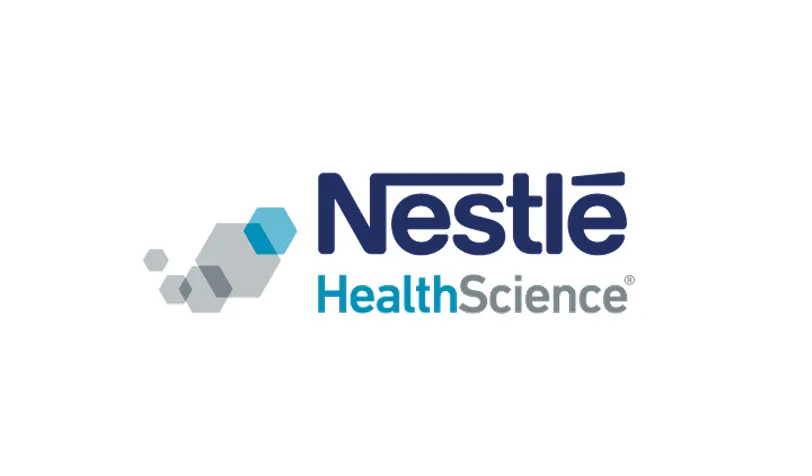
Nurturing the immune system in CMPA: The Role of HMO and Lactose in Formula-Fed Infants
Join Paediatric Gastroenterologist and Allergist, Dr Ralf Heine, for an insightful session exploring the emerging benefits of Human Milk Oligosaccharides (HMOs) and Lactose in formula-fed infants with Cow’s Milk Protein Allergy (CMPA). This webinar will highlight how these components support immune system development in a compromised population, offering a deeper understanding of their role in allergy management.
See moreExternal Link
The 2025 ERAS guidelines mark a major leap in perioperative nutrition care, introducing preoperative immunonutrition and refined postoperative strategies. With stronger evidence and a proactive approach, they offer essential tools for optimising outcomes in colorectal surgery.
In this international survey, it explores current knowledge gaps regarding malnutrition and dysphagia among healthcare professionals across 54 countries and discusses opportunties for improved care, management and identification strategies.
In this meta-analysis of randomised control trials, it details how texture-modified diets increase dietary intake of energy and protein in addition to fluif intake for adults with dysphagia.
In this retrospective observational study it examines the increased nutritional risks in adults who undergo GLP-1 RA therapy, including those with type 2 diabetes, prediabetes, and obesity.
This case report presents the clinical experience with four cases of post-stroke dysphagia. A comprehensive approach to management with thickened fluids decreased the risk of aspiration pneumonia and facilitated effective management of dietary recommendations both during hospitalisation and after discharge.
The present guideline provides 32 evidence-based recommendations and 8 statements for hospitalised patients with acute or chronic kidney disease, defining how to assess nutritional status, how to define patients at risk, how to choose the route of feeding, and how to integrate nutrition with kidney replacement therapy.
This literature review demonstrates that the EAT-10 dysphagia screening tool can be used as a primary screening instrument for detecting dysphagia in routine clinical practice, and provides complementary information to other diagnostic tools.
Children with developmental delays are often dependent on enteral nutrition. This study evaluated the benefits of switching to a 100% whey, peptide-based formula from an intact protein based formula, which resulted in improved symptoms of feeding intolerance in the majority (92%) of developmentally delayed children eligible for the study.
An open label, randomised, crossover study that looks at the effect and tolerance of a diabetes-specific formula on acute glucose, insulin, and triglyceride responses in patients with type 2 diabetes mellitus (T2DM). This study demonstrated that the diabetes-specific formula resulted in lower post-meal blood glucose and insulin levels as compared with an isocaloric meal.
Gastrointestinal intolerance is a common problem with enteral nutrition. This randomised controlled trial investigated the influence of a soluble fibre known as PHGG (partially hydolysed guar gum) in medical and surgical enterally fed patients with GI intolerance. Results demonstrated that enteral nutrition supplemented with PHGG lowered diarrhoea rates in patients receiving total and supplemental enteral nutrition, as well as experiencing fewer side effects and less interruption to feeding schedules.
Information for health professionals on nutrition management of critically ill patients, including guidelines on the nutritional management of COVID-19. Please note that all clinical decisions need to be made by the healthcare professional, taking the medical information of the patient into consideration.
A national, anonymous 41-question, online purpose-designed survey explores whteher older adults understand and value muscle health, tjheir avility to take action and overall knowledge and confidence to manage their health.
A national, anonymous 33-item, online purpose-designed survey of GPs and Practice Nurses explores awareness and attitudes toward sarcopenia, and how clinicians play a role in its management. Barriers to effective implementation in primary practice are also identified and discussed.
40 recommendations for nutritional care of older persons with dementia were developed with an emphasis on nutritional adequacy being an integral part of dementia management.
This research explores participant acceptability, adherence, safety, and experiences of using a short-term total diet replacement and a food-based low energy diet in adults living with chronic kidney disease and obesity.
The Global Leadership Initiative on Malnutrition (GLIM) provides consensus criteria for the diagnosis of malnutrition that can be widely applied. However, once malnutrition is diagnosed, skeletal muscle function should be investigated as a relevant component of sarcopenia and for complete nutrition assessment of persons with malnutrition. Barazzoni et al. 2022; Clinical Nutrition, 41 (6): 1425-33.
An Australian based open-label, non-randomized, multicenter trial by Gold et al. 2022 uses an amino acid-based formula (AAF) supplemented with two human milk oligosaccharides (HMO) to demonstrate normal growth, good tolerance and significant microbiome shift in infants with a cow’s milk protein allergy (CMPA).
In a randomised multicenter trial by Puccio et al. 2017, it demonstrates that infant formula with 2'FL and LNnT is safe, well-tolerated, and supports age-appropriate growth. Secondary outcome findings show associations between consuming HMO-supplemented formula and lower parent-reported morbidity (particularly bronchitis) and medication use (antipyretics and antibiotics).
In a randomised clinical trial by Vandenplas et al. 2022, using an extensively hydrolyzed formula (EHF) supplemented with two human milk oligosaccharides (HMO) in infants with cow’s milk protein allergy (CMPA), it demonstrated a reduction in frequency of upper respiratory tract infections and a lower incidence of ear infections at 12 months as well as supporting normal growth in infants with CMPA.
Children with medical complexity switched to AA-MCT formula demonstrated growth. Formula was well tolerated, as shown by increased intake of formula, appropriate growth for age and BMI z-scores up to 1 year post-switch.
A systematic review looking at the positive effects of immunonutrition in head and neck cancer patients undergoing cancer treatment in improving or maintaining nutritional status.
Markovic, TP. et al 2022 An algorithm has been developed to (i) assist primary care physicians in treatment decisions for non-pregnant adults with obesity, and (ii) provide a practical clinical tool to guide the implementation of existing guidelines for the treatment of obesity in the Australian primary care setting.
This article aims to review the latest nutrition care recommendations for the prevention and treatment of pressure injuries, including recommendations tailored to special populations. A secondary objective is to translate nutrition recommendations into actionable steps for the healthcare professional to implement as part of a patient plan of care.
Consensus recommendations were established based on eight clinically relevant questions regarding enteral nutrition (EN) indications as deemed by the Enteral Nutrition Committee. These consensus recommendations may act as a guide for clinicians and stakeholders on difficult questions pertaining to indications for EN. This paper was approved by the ASPEN Board of Directors.
The lectures highlight the role and use of nutrition intervention for diabetes management and potential to achieve diabetes remission. Topics include weight management and very low energy diets, use of nutritional supplements in diabetes care, and sarcopenia and diabetes.
These recommendations were developed by a panel of experts in the area of gastroenterology, and include recommendations on the use of fibre in enteral nutrition, such as PHGG (partially hydrolysed guar gum). ‘To prevent enteral nutrition induced diarrhoea in post surgical and in critical ill patients, supplementing enteral nutrition with PHGG is effective.' (Recommendation A)
Nutrition support during the acute phase post allogeneic haematopoietic stem cell transplantation (HSCT) is required to optimise short- and long-term outcomes for children. An algorithm was developed and evaluated to assist clinicians to make objective and consistent enteral feeding decisions and has shown to help support better weight outcomes and reduced LOS in this patient cohort.
This webinar informs on the emerging research demonstrating the benefits of partially hydrolysed guar gum (PHGG) for a range of health outcomes, including gut health and as a prebiotic. PHGG exerts the nutritional function of a dietary fibre, while being very low viscosity in solution. This webinar explores PHGG and its specific benefits for gut health.
This retrospective observational audit describes the characteristics of the paediatric patients who have been prescribed a hydrolysed whey protein, medium chain triglycerides (MCT) based formula, Peptamen Junior® and the nutritional outcomes. This study demonstrates that semi elemental formula Peptamen Junior® appears to be well tolerated in paediatric patients with a variety of medical conditions that have complex pathologies and may have wider scope of use in a more diverse group of medical conditions than currently indicated.
This review addresses the critical role of nutrition therapy in perioperative optimisation to improve surgical outcomes. It describes recent evidence for screening and treatment and practical guidance on perioperative nutrition care pathways for patients requiring major surgery.
This webinar discusses the ageing process and how ageing affects the musculoskeletal system and its key determinant of mobility impairment, how ageing affects nutritional status of older people, the relationship between malnutrition, sarcopenia and frailty and how malnutrition in older adults can be addressed with specific nutrients with optimal protein and omega-3 ingestion and loading.
This review covers the importance of early, multi-modal nutrition interventions across the continuum of care that are individualised and can improve the outcomes of those with COVID-19. The authors describe multi-modal nutritional therapy which includes a combination of nutritional interventions, e.g. dietary counselling, food fortification, texture modification, thickened fluids, oral nutritional supplements, enteral tube feeding, chosen depending on the individual needs of the patient, in addition to the use of specific individual nutrients, e.g. protein, vitamin D, omega-3 fatty acids, where appropriate (for muscle-targeted nutritional support).
This presentation focuses on the epidemiology and pathophysiology of long COVID and addresses its nutritional consequences and potential treatment options. Access this webinar on demand on the ASPEN website (register for FREE).
This study demonstrates that the use of Sn-2 formula compared to standard infant formula may be associated with improved behaviors and stool characteristics in infants.
This study looks at gastrointestinal tolerance, acceptability and safety of high sn-2 infant formulas among healthy term infants by measure of stool frequency and associated characteristics, and general gut symptoms.
This study looks at the effect of increasing the amount of palmitic acid esterified in the sn-2 position in infant formula on neurodevelopment in healthy full-term infants and explores association of this effect with the altered gut Bifidobacteria.
This podcast explores how prebiotic fibre differs from other fibres and probiotics, and its specific role in supporting gut health. It also touches on which patients benefit from boosting their prebiotic intake and debunks some of the most common myths in the gut health space. In particular the podcast will explore diets that are typically low in prebiotic goodness, how prebiotic fibres can alleviate symptoms of constipation, the role of Partially Hydrolysed Guar Gum (PHGG), a type of prebiotic fibre and top tips for dietitians who see patients with gut health issues.
This study aims at Identifying the risk factors for dysphagia in ICU patients with COVID-19 pneumonia requiring invasive mechanical ventilation, and at determining the frequency of postextubation dysphagia in this population.
Type 2 diabetes mellitus (T2DM) and non-alcoholic fatty liver disease (NAFLD) are highly prevalent diseases associated with an increased risk of morbidity and mortality. Obesity/overweight and dietary intake are important risk factors. Jamy Ard focused on the benefits of meal replacements to promote increased weight loss and increased rates of T2DM remission. Wajahat Mehal discussed sustained weight loss and improved liver health and focused on meal replacements and very-low-calorie diets (VLCD)for the management of NAFLD/NASH.
This pilot randomised control trial tests the feasibility and potential efficacy of remotely supported intermittent low-energy diets (ILEDs) and continuous low-energy diets (CLEDs) in people with type 2 diabetes (T2D). The study demonstrated feasibility and efficacy for remote ILEDs and CLEDs for weight loss and HbA1c reduction.
Guidelines for the provision of nutrition support therapy in the adult critically ill patient by The American Society for Parenteral and Enteral Nutrition(ASPEN). This guideline updates recommendations made from the 2016 American Society of Parenteral and Enteral Nutrition(ASPEN)/Society of Critical Care Medicine(SCCM) critical nutrition guideline for five foundational questions central to critical care nutrition support.
This podcast, which features dietitian and researcher Gabrielle Maston, explains what VLEDs are and tips and tricks to improve the compliance of patients on a VLED. It discusses the results of the DiRECT trial and the role of VLEDs in diabetes remission. It explores why dietitians are hesitant to prescribe VLEDs and how they can improve their confidence in recommending VLEDs to patients and clients. This podcast was hosted and created by Dietitian Connection.
This podcast which features Dr Emma Ridley, who is a Senior Research Fellow and Senior Clinical ICU Dietitian, discusses the nutrition consequences, typical nutrition intake and barriers and nutritional management of patients in ICU, including strategies to improve nutrition intake post-ICU, particularly for COVID-19 patients.
This podcast, which features psychologist Glenn Mackintosh, discusses the psychological aspects to consider when a client is trying to lose weight, such as what to consider when a client walks into a clinic for weight loss advice, importance of support from a professional and how to help clients normalise lapses and relapses. This podcast was hosted and created by Dietitian Connection.
Recent years have seen a surge in popularity of eating patterns involving intermittent fasting as a way to manage and optimise health. This webinar reviews the health and physiological benefits of intermittent fasting, exploring the two most popular forms of intermittent energy restriction (The 5:2 Diet and Alternate-Day fasting).
COVID-19 presents significant challenges, not only in caring for patients, but also the mental health of those looking after the patients. This webinar shares practical evidence based strategies from a health psychologist to help clinical dietitians manage stress, maintain optimism, and cultivate self-compassion during this difficult and uncertain time.
In this webinar, clinical dietitian Steph Yap and community dietitian Kate Dacanay discuss the different pathways they use to manage malnourished patients in their respective settings, focusing on optimal transition from hospital to community and reflect on the challenges that COVID-19 has presented in their work.
This clinical paper reviews the evidence available on the use of thickening agents for the management of dysphagia. It includes discussion on different types of thickeners, and looks at their effects on the bioavailability of water, absorption of medications and feelings of satiety when consuming different viscosities.
This study investigates the therapeutic effect of a xantham-gum based thickener on the swallowing function of patients with dysphagia. Results demonstrated that the xanthan-gum based thickener improves the safety of swallow without increasing residue providing a viscosity-dependent therapeutic effect for patients with oropharyngeal dysphagia.
This study assesses the feasibility of thickening video fluoroscopic contrast agents for dysphagia, including using a xantham gum-based thickener. The results showed that for optimal patient outcomes, only diagnostic materials and thickening agents for which reliable viscosity data are available should be used.
The use of thickening agents to alter bolus rheology is particularly commonplace; however, the precise effects of these alterations on swallowing remain uncertain. The aim of this study was to compare the effects of a thin contrast fluid versus a contrast fluid thickened with a xanthan gum-based thickener and a starch-based thickener.
This comparative study investigates the safety and efficacy of a xanthan gum-based versus a starch-based thickener in post-stroke patients with oropharyngeal dysphagia. Both thickeners were effective in improving swallowing safety however the xanthan gum-based thickener does not increase the prevalence of oral and pharyngeal residue, better avoiding the risk of aspiration after the swallow.
Paediatric Nutrition in Practice (PNP) eLearning Program aims to provide information to healthcare professionals who are looking for practical guidance on relevant issues surrounding the nutrition management of infants, children and adolescents. This eLearning Program has 12 modules that can be completed.
This study was to determine the effect of an intermittent defined formula diet on growth and disease activity in children with Crohn’s disease and growth failure. The results indicate that an intermittent defined formula diet can improve growth failure and significantly decrease disease activity in children with Crohn's disease.
Neurological disability is often associated with feeding and gastrointestinal disorders leading to malnutrition and growth failure. These clinical guidelines by ESPGHAN provide necessary nutritional and clinical guidance including assessment and monitoring of nutritional status, definition of nutritional requirements, diagnosis and treatment of gastro-oesophageal reflux disease, and indications for and modalities of nutritional support.
This single blind case control study aim was to compare the effect of a peptide-based formula versus a standard polymeric formula on feeding tolerance parameters and other clinical outcomes among critically ill children. The study found that the peptide-based formula feeding was better tolerated than standard polymeric formula feeding in critically ill pediatric patients. However, the choice of patients receiving the peptide-based formula needs to be further evaluated.
This study showed whey-based formulas reduce the number of episodes of vomiting by improving the rate of gastric emptying in patients 3 years or older with profound mental retardation, spastic quadriplegia, developmental delay, and scoliosis in comparison to patients that were fed casein-based formula.
The objective of this study was to compare anthropomorphic measures and dietary intake of calcium, vitamin D, total calories, protein and fat between children with and without reported food allergy using The National Health and Nutrition Examination Survey (NHANES). This study which showed that mean weight, height, BMI & height-for-age percentile and calcium intake were significantly lower in children aged 2-17 years compared with those without CMPA.
This study looked at the heterogeneity of extenstively hydrolysed formulas (eHFs) and compared the molecular weight profiles among eHF's from different manufacturers. The survey highlights the need for a more meaningful definition of EHF products. However, the clinical implications of it's findings are uncertain and further studies are required.
HMO academy- Human Milk Oligosaccharides (HMOs)are an exciting and central area of research in infant nutrition. Scientific advances on HMOs are helping us know more about the role and importance of these essential components of Human milk. The HMO Academy has been created to share evidence-based information in interactive and user-friendly way from more than a decade of research on HMO.
An online symposium from Nestlé Health Science presented by Dr. Rosan Meyer, Prof. Kari Nadeau and Dr. Carina Venter that looks at the nutritional strategy to prevent food allergy. This webinar discusses the topics such as the introduction of solid foods, making sense of allergy prevent guidelines around the world and diversity of foods .
A double-blind randomised clinical trial in which he results indicated that consumption of a high beta-palmitate formula affects infant crying patterns during the first weeks of life, reducing crying duration and frequency, primarily during the afternoon and evening hours, thereby improving the wellbeing of formula fed infants and their parents.
In this randomised, double-blind controlled trial, it evaluated the impacts of infants consuming high beta-palmitate (Sn-2) formula on anthropometric measures and bone strength. After 12 weeks of consumption, changes in bone SOS (speed of sound) were comparable to those infants consuming breast milk and favourable compared to infants consuming low beta-palmitate (Sn-2) formula.
A double-blind, randomised trial of a synthetic triacylglycerol in formula-fed term infants that demonstrated infants fed the higher sn-2 formula compared to a standard formula, measured bone mineral content, softer stools and lower stool fatty acid soaps, similar to that of breast-fed infants. The study noted that the greater bone mass measured could be important if it persisted beyond the trial period and would merit further investigation.
This study demonstrated that infant formula enriched with sn-2 palmitate fed in infantcy is safe, improves stool consistency (from 2 weeks to 2 months) and increase bone mineral content (at 4 months).
Patients with cancer are at particularly high risk for malnutrition because both the disease and its treatments threaten their nutritional status. However, cancer-related nutritional risk is sometimes overlooked or under-treated by clinicians, patients and their families. These ESPEN expert group recommendations provide clinical guidance in managing cancer related malnutrition.
Evidence based guidelines which were developed to translate current best evidence and expert opinion and translated into recommendations for multi-disciplinary teams responsible for identification, prevention, and treatment of malnutrition in adult cancer patients. These guidelines were commissed and financially supported by ESPEN and by the European Partnership for Action Against Cancer(EPAAC).
A comparative study that showed that early nutritional intervention in patients with Head and Neck Cancer (HNC) receiving concurrent chemoradiotherapy resulted in improved treatment tolerance and fewer admissions to hospital. Suggesting that nutritional intervention must be initiated before chemoradiotherapy, and continued after treatment completion.
A study evaluating the benefit of oral nutritional supplements(ONS) in addition to nutritional counselling in head and neck cancer(HNC) patients undergoing radiotherapy. HNC patients receiving radiotherapy and nutritional counselling with ONS had better weight maintenance, protein-calorie intake and quality of life than those patients who did not receive ONS.
This program reviews the latest evidence around the role of nutrition intervention for the prevention and treatment of cancer. Learn about the role of CT scans as predictors of outcomes and identifying hidden sarcopenia and understand how cancer death is related to chronic inflammation. Several common nutrition supplements are reviewed including fish oil, types and amount of protein, antioxidants, vitamin D, probiotics and more recent data around Specialized Pro-resolving Mediators (SPMs).
A systematic review and meta-analysis evaluating the impact of partially hydrolysed guar gum(PHGG) supplementation on constipation related outcomes in apparently healthy individuals. Results suggested that PHGG consumption led to a favourable impact on constipation prevention of the similar magnitude that was achieved with laxatives.
This study evaluated the progress of symptoms and the modifications in the frequency of evacuations in subjects affected by irritable bowel syndrome and regularly taking PHGG. The study demonstrated that PHGG inclusion in the diet assists in the dietary management of IBS and helps to manage the incidence of flatulence, pain and bloating.
The aim of this prospective study was to investigate the effect of guar gum on colonic transit time (CTT) and symptoms of chronic constipation. The results showed that four-week PHGG use accelerates colon transit time in patients with chronic constipation, especially in those with slow transit, and improves many of their symptoms including frequency of bowel movements.
The effects of partially hydrolysed guar gum (PHGG) were compared in a multicentre randomised open trial in patients with irritable bowel syndrome for 12 weeks. Gastrointestinal symptoms, quality of life and psychological symptoms were evaluated and improved significantly after the first month of administration until follow-up compared to those at baseline.
A systematic review and meta-analysis on the benefits of nutritional support in patients with type 1 or type 2 diabetes. This study demonstrated that that short and long term use of diabetes-specific formulas such as oral nutrition supplements and tube feeds are associated with improved glycaemic control compared with standard formulas.
A randomised, clinical trial exploring the effect of skipping breakfast on blood glucose levels after a subsequent isocaloric lunch and dinner. The study found that skipping breakfast increases post-prandial glucose levels after lunch and dinner, demonstrating a long-term influence of breakfast on glucose regulation throughout the day.
This guideline aims to cover nutritional aspects of the Enhanced Recovery After Surgery(ERAS) concept and the special nutritional needs of patients undergoing major surgery and of those developing severe complications despite best perioperative care. This guideline presents 37 recommendations for clinical practice.
ASPEN Guidelines for the Provision and Assessment of Nutrition Support Therapy in the Adult Critically Ill Patient. This guideline also answers a range of questions in relation to the provision and assessment of Nutrition Support Therapy which healthcare professionals can use in providing care for the adult critically ill patient.
This practical guideline gives guidance to health care providers involved in the management of cancer patients to offer optimal nutritional care. A total of 43 recommendations are presented with short commentaries for the nutritional and metabolic management of patients with neoplastic diseases. The disease-related recommendations are preceded by general recommendations on the diagnostics of nutritional status in cancer patients.
ESPEN provide updated guidelines on clinical nutrition in ICU. These guidelines define who are the patients at risk, how to assess nutritional status of an ICU patient, how to define the amount of energy to provide, the route to choose and how to adapt according to various clinical conditions. When to start and how to progress in the administration of adequate provision of nutrients is also described.
This ESPEN guideline will help inform healthcare professionals about the indications and contradictions for home enteral nutrition (HEN), and it’s implementation and monitoring. The guideline is based on current evidence and expert opinion and consists of 61 recommendations that address the indications for HEN, relevant access devices, products recommended, monitoring and criteria for termination of HEN, and the structural requirements needed to perform HEN.
This prospective double blind, controlled study evaluates the use of partially hydrolysed guar gum (PHGG) in enteral feeds, to prevent diarrhoea in intensive care unit (ICU) patients. The results showed that enteral nutrition formulae enriched with PHGG was related to a decrease of diarrhoeal episodes in ICU patients with pre-existing diarrhoea.
This randomised controlled trial investigated the use of PHGG (partially hydolysed guar gum) in critically ill patients with diarrhoea receiving enteral nutrition. The results illustrated that total enteral nutrition supplemented with soluble fibre is beneficial in reducing the incidence of diarrhoea in tube-fed full-resuscitated and mechanically ventilated septic patients.
A randomised, double-blind, clinical trial which investigated the effect of FODMAP content in enteral nutrition formula on gastrointestinal intolerance and nutrition status in hospitalised patients. The results demonstrate that low-FODMAP enteral nutrition improves diarrhoea and nutritional status in patients receiving enteral nutrition.
A controlled clinical trial which aimed to compare the effects of a renal-specific oral nutrition supplement (RS-ONS) and a standard recommended nutrition regime on biochemical and nutrition markers in malnourished patients with CKD on hemodialysis. Long-term oral nutrition supplementation improves outcomes in malnourished patients with chronic kidney disease on hemodialysis.
Protein energy wasting (PEW) is common in patients with chronic kidney disease (CKD) and is associated with adverse clinical outcomes, especially in individuals receiving maintenance dialysis therapy. This publication is an International Consensus Statement by the International Society of Renal Nutrition and Metabolism on the prevention and treatment of protein energy wasting in chronic kidney disease patients.
This systematic review looks at potential benefits of nutrition support (oral or tube feeding) in patients with chronic kidney disease. The study suggests that enteral multinutrient support significantly increases serum albumin concentrations and improves total dietary intake which may benefit clinical outcome, especially in malnourished patients.
Outcomes associated with intradialytic oral nutritional supplements in patients undergoing maintenance hemodialysis: a quality improvement report. This report showed that maintenance hemodialysis patients with albumin levels ≤3.5 g/dL who received monitored intradialytic oral nutritional supplements showed survival significantly better than similar matched patient controls, with the as-treated analysis highlighting the potentially large effect of this strategy in clinical practice.
The MNA® (Mini Nutrition Assessment) tool was designed and validated in numerous studies in Europe and the U.S over the course of 5 years. At the publication date of this paper, the MNA® was utilised in over 2000 clinical research all over the world, ranging from community care to hospital settings. This paper reviews 30 years of clinical research and practice which has utilised the MNA® tool worldwide.
A randomised controlled trial that investigated the use of a short-term nutritional intervention consisting of oral nutritional supplements and calcium and vitamin D supplementation and supported by dietetic counseling in malnourished older adults decreases the number of patients who fall and fall incidents.
A cluster randomised controlled study examined whether the nutritional status of aged undernourished residents in care could be improved through dietary modification to increase energy intake but not portion size. Results suggest that enriching food could help address undernutrition and slow chronic weight loss. Interventions of a longer duration are needed to confirm or exclude the value of food enrichment.
This systematic review highlights that the use of Oral Nutritional Supplements (ONS) use in community and care homes produces an overall cost advantage. Many clinically relevant outcomes favouring ONS were reported: improved quality of life, reduced infections, reduced minor post-operative complications, reduced falls, and functional limitations. Of the cost-effectiveness analyses involving quality adjusted life years or functional limitations, most favoured the ONS group.
Few trials have explored the effect of nutrition support on quality of life (QoL). This randomised controlled trial of 104 malnourished residential care residents indicates that oral nutritional supplements (ONS) can improve quality of life (QoL) and nutritional intake more effectively than dietary advice alone.
In this updated systematic review and meta-analysis of 27 trials including 6803 patients, nutritional support provided during hospitalisation was associated with: Significantly lower rates of mortality (24% risk reduction) (primary study outcome) (P=0.03) Significantly lower nonelective hospital readmissions (secondary study outcome) (P=0.02) Higher energy and protein intake (secondary study outcome) and weight increase (secondary study outcome).
A randomised controlled trial which had the aim of investigating whether providing a lower volume of ONS at a higher frequency during medication rounds would improve the intake of supplements. The results showed that a higher frequency of a lower volume of ONS during medication rounds increased the compliance of patients needing ONS.
This systematic review demonstrates the cost and cost effectiveness of using standard oral nutritional supplements (ONS) in the hospital setting. The mean cost saving was ~12% and was associated with significantly improved outcomes such as reduced mortality, reduced complications and reduced length of hospital stay.
To help older people (>65 years) maintain and regain lean body mass and function, the PROT-AGE study group recommends average daily intake at least in the range of 1.0 to 1.2g protein per kilogram of body weight per day. Additionally, both endurance and resistance type exercises are recommended at individualised levels that are safe and tolerated.
MNA® (Mini Nutritional Assessment) is a validated nutrition screening/assessment tool to identify individuals 65 year and above who are malnourished or at risk of malnutrition. The online resource utilises a number of questions which patients answer and provides them with a score at the end in which they can determine what category they fit into whether they have: a normal nutritional status, at risk of malnutrition or malnourished.
This pilot study demonstrates the potential for a specialised wound healing nutritional supplement to accelerate the rate of pressure ulcer healing in spinal cord injury patients. A 2.5-fold greater rate of healing was observed in patients consuming the arginine-containing nutritional supplement until full healing compared with those who ceased taking the supplement.
In this clinical study, spinal-cord injured patients with pressure ulcers received a commercial powdered nutritional supplement containing 9g of arginine per day. An approximate 2-fold improvement in pressure ulcer healing was seen in well nourished community spinal patients receiving the arginine-containing nutritional supplement, compared with historical controls.
In this clinical study, hospital inpatients with pressure ulcers were randomised to receive daily a standard hospital diet; a standard diet plus two high-protein/energy supplements; or a standard diet plus two high-protein/energy supplements containing additional arginine, vitamin C and zinc. Subjects receiving the arginine-containing nutritional supplement had a significantly improved rate of pressure ulcer healing over the course of three weeks.
Evidence based guidelines by the Trans Tasman Dietetic Wound Care Group on the dietetic management of adults with pressure injuries. The recommendations made are designed to guide practice and assist in the decision making process that is undertaken when assessing and treating patients. A Trans-Tasman approach was taken for the review of these guidelines to facilitate use by New Zealand Registered Dietitians as well as Australian Accredited Practicing Dietitians.
An eLearning module from Nestlé Health Science which discusses nutrition for wound healing and management. This education module goes through the three stages of wound healing, why wounds may fail to heal, the nutritional management of wounds and highlights individuals who are most at risk of pressure injuries.
Algorithm for prevention of pressure injuries
Malnutrition is known to contribute to wound development and impair wound healing through reduction in the availability of nutrients to maintain optimal cell maintenance and repair. This review examines studies from the last decade to identify evidence for the effectiveness of nutritional interventions in wound healing. Studies reported identified included 61 primary studies and 6 systematic reviews.
A randomised controlled trial which investigated the rate of weight loss on the rate of regain in people who are obese (fast versus slow weight loss). The interpretation of the results were that the rate of weight loss does not affect the proportion of weight regained within 144 weeks. These findings are not consistent with present dietary guidelines which recommend gradual over rapid weight loss, based on the belief that rapid weight loss is more quickly regained.
A review and meta-analysis of the benefits of weight management for those who are at risk or have type 2 diabetes. As obesity is a major risk factor for development of diabetes, a systematic review of the medical literature to assess the impact of obesity and weight gain on risk of diabetes and CHD was conducted.
A randomised control trial investigating the use of energy restricted diets delivered through primary care channels, with the aim of achieving remission for people with type 2 diabetes. Findings show that, at 12 months, almost half of participants on a total diet replacement program achieved diabetes remission.
This review paper addresses questions surrounding the use of very low energy diets (VLEDs) for the management of overweight/obesity. It discusses fast versus slow weight loss and long-term results, as well advantages of VLEDs, side effects, and how it should be used. Behavioural change, active follow-up and pharmacotherapy are also discussed for optimal results.
This review paper explores the properties and current status of very low energy diets (VLEDs) in the management of obesity. VLEDs are defined as diets which contain energy levels of less than 3.4MJ (800kcal) per day and contain daily allowances of all essential nutritional requirements and have been used in clinical settings for over 20 years.
A very low energy diet (VLED) can result in substantial, rapid weight loss and is increasingly prescribed before obesity surgery to minimise risk and difficulty by reducing liver size and abdominal adiposity. This observational study demonstrates the efficacy of using a VLED pre-bariatric surgery for 2-6 weeks.
The effects of overweight and obesity are widely recognised as one of Australia’s leading health concerns, involving all age and socioeconomic groups. These Guidelines are designed for use primarily at the level of the individual who is overweight or obese, while acknowledging that individual choices are shaped by the wider environmental and social context. The evidence-based recommendations and practice points focus on clinical and physical aspects of care.
Article
Making Informed Choices for the Nutritional Management of Infants with CMPA
CoMiSS® is the Cow’s Milk-related Symptom Score. It is a simple, fast, easy to use, non-invasive tool which helps increase awareness of the most common symptoms seen in infants with CMPA, supporting earlier diagnosis. The CoMiSS® tool was first developed by international experts in 2015 to support healthcare professionals (HCPs) with the diagnosis of CMPA. Since 2015, 25 clinical studies have been conducted using the CoMiSS™ tool. It is intended to be used by healthcare professionals in conjunction with caregivers.
Watch this two-part recorded webinar series, presented by Dr. Tim Crowe, as he explores the latest research and practical applications of Collagen Peptides in clinical practice. Designed for healthcare professionals, this series will provide valuable insights into the clinical benefits of collagen peptides and how they can be utilised to enhance patient care.
EXTENSIVE HA™ is a specialised whey based, extensively hydrolysed infant formula (eHF), suitable for mild to moderate Cow’s Milk Protein Allergy (CMPA).
Breaking Barriers to Oral Nutritional Interventions in Older Adults with Malnutrition
As part of the Satellite Symposium at 46th ESPEN Congress on Clinical Nutrition and Metabolism, Milano, Italy, Prof. Phillips discusses the importance of protein, specific amino acids and the role they play in muscle mass physiology.
The Mini Nutritional Assessment (MNA®) is a validated screening tool to help identify individuals over the age of 65 who are malnourished or at risk of malnutrition to help determine nutritional status. This guide provides recommended nutrition interventions based on the patients' MNA® scores.
Purposefully designed with wholesome and familiar food ingredients to meet the nutritional needs of children requiring enteral nutrition.
Nutritionally complete paediatric tube feed with a unique blend of whole foods
Compleat® paediatric is a nutritionally complete 1.2kcal/ml standard enteral tube feed, containing food-derived ingredients (rehydrated chicken meat and vegetables, peach puree, orange juice from concentrate). Compleat® paediatric is a Food for Special Medical Purposes for use under medical supervision.
Utilise one of our recipes with an addition of SUSTAGEN, to help assist you with your dietary needs or goals
One challenge that arises after the completion of any weight loss therapy is weight regain. OPTIFAST VLCD products can be beneficial to help individuals maintain nutritional balance and reduce overall caloric intake to support continued weight management.
Would your patients on GLP-1 RAs benefit from nutrition support? OPTIFAST VLCD products can help meet nutritional requirements when appetite is affected by GLP-1 RA therapy.
This retrospective review evaluates real world clinical experience of concomitant use of meal replacement products and GLP-1 RAs in Australia and South Africa. The results illustrate that this combination for weight management is feasible in real-life and may offer potential advantages for weight management.
This study aimed to determine the demographic, eating, self‐efficacy and program engagement characteristics of VLCD users in Australia (regular vs. intermittent users) and associations with self‐perceived program success on weight loss, quality of life (QOL), mental health and physical health.
This online training course has been developed in consultation with IDDSI, to enhance knowledge for non-speech pathologists working with individuals with dysphagia. It discusses the ‘what’ and ‘how’ of the IDDSI Framework, and will take approximately 1 hour to complete. Author: Nestlé Health Science, in consultation with IDDSI
This publication provides current knowledge on pureed foods for people with dysphagia, developed by 6 global experts. Topics include chewing and swallowing solid foods, tools for screening and assessment, texture-modified diets in residential care settings, and benefits of commercially prepared pureed foods. Author: Experts on Chewing and Swallowing disorders and Nestlé Nutrition Institute
The Nutritional Support in Children with Neurological Impairment brochure is an ideal resource on how to support children with Cerebral Palsy in their nutritional management, taking a wholistic and multi-disciplinary approach. This resource is ideal for those in the field of Neurology, Gastroenterology, Physiotherapy, Nursing, Speech Therapy, Social Work, and Nutrition and Dietetics.
This resource explains how the Calcium Calculator tool works and why it can be beneficial for parents of children with Cow’s Milk Allergy (CMA). The Calcium Calculator is an online tool containing a list of food that can be sources of calcium, and helps measure the calcium intake of a child with CMA.
A recipe brochure for patients which uses THICKENUP Clear and SUSTAGEN Hospital Formula Neutral Flavour to create a No Melt Ice cream. The recipe also provides patients with serving suggestions as well as an indication of what IDDSI Framework Level this can be utilised in.
A brief guide for those using ARGINAID with information on essential nutrients and foods that assist with wound healing, as well as practical tips to improve nutritional intake. This guide includes an overview of nutrient intake guidance, meal planning suggestions, as well as practical tips to help encourage a balanced diet.
An information booklet for patients recommended IMPACT Advanced Recovery. The booklet provides educational information on surgical site infections as well as tips to reduce the risk of infection after surgery. The resource all details how immunonutrition can support the recovery process, including how IMPACT Advanced Recovery works, recommended usage, and recipes.
The EAT-10 is a validated dysphagia screening tool which is provided in an interactive format for accessibility and ease of use. This tool can be used by anyone to screen for symptoms of dysphagia, and refer on for further assessment if possible dysphagia is identified. It consists of 10 questions which provides an overall score (completed within 2 minutes).
An online resource that outlines meta-analyses data in major elective surgery and health economic information on the use of immunonutrition products such as IMPACT Advanced Recovery perioperatively. This brochure highlights how IMPACT Advanced Recovery can support the nutritional management of patients undergoing major elective surgery at risk of infection through the use of statistics as well as outlining the products key benefits and features.
This online resource provides an overview of the clinical uses of NOVASOURCE Renal and identifies the nutritional problems and associated needs of patients with compromised renal function. Additionally, it summarises how NOVASOURCE Renal is able to meet these needs by highlighting the key features and benefits.
A comprehensive guide focusing on the value of nutrition in wound management, specifically written for health care professionals. This guide aims to provide simple advice on the role of nutrition in wound healing for healthcare professionals involved in the management of wounds; provide practical guidance on when and how to implement nutritional support to help promote wound healing and summarise the evidence for the relationship between nutrition and wound healing.
This exciting initiative across a select range rolls out from March with full availability by August. Find out more information here. Download Resource Plus Product Information Sheet
Li ML, Zhang F, Luo HY, Quan ZW, Wang YF, Huang LT, Wang JH. Improving sarcopenia in older adults: a systematic review and meta-analysis of randomized controlled trials of whey protein supplementation with or without resistance training. J Nutr Health Aging. 2024 Apr;28(4):100184 Results from Ten randomised control trial studies including 1154 participants, demonstrate the value of whey protein (9.6-40g per day) supplementation in adults with sarcopenia. When compared to Isocaloric placebo (PLA)/Routine consultation (RC) group, whey protein consumption significantly increased appendicular skeletal muscle mass index and muscle mass in addition to gait speed.
Lee SY, Lee HJ, Lim JY. Effects of leucine-rich protein supplements in older adults with sarcopenia: A systematic review and meta-analysis of randomized controlled trials. Arch Gerontol Geriatr. 2022 Sep-Oct;102:104758. Data from six randomised controlled trials including a total of 699 participants, demonstrate that the consumption of leucine-rich protein supplements (offering 3-6g leucine per day) can improve muscle strength, muscle mass and performance in sarcopenic older adults compared to a control group (P<0.001) and may be suggested as a nutritional treatment for sarcopenia.
B. Komar, L. Schwingshackl, Georg Hoffmann, Effects of leucine-rich protein supplements on anthropometric parameter and muscle strength in the elderly: A systematic review and meta-analysis, The Journal of nutrition, health and aging, Volume 19, Issue 4, 2015, Pages 437-446 Leucine supplementation has shown to significantly increase gain in body weight (p=0.02), lean body mass (p=0.0005) and body mass index (p=0.001) compared with control groups. Furthermore, the benefit of leucine supplementation has a more profound impact on body weight and lean body mass in individuals who have pre-existing sarcopenia.
Introduce RESOURCE® Crema 2.0 a delicious pudding style energy dense, high protein, low volume oral nutritional supplement. Each ready to consume 125g tub is nutritionally complete and suitable as a sole source of nutrition, which makes it great to provide variety or to be used as an alternative to liquid oral nutritional supplements. Learn more here.
RESOURCE® ULTRA+ 125ml is an energy dense, high protein, low volume oral nutritional supplement. RESOURCE® ULTRA+ has a unique, premium blend of high-quality proteins (60% whey protein, as a percentage of total protein) designed to promote gains in lean body mass. Learn how RESOURCE® ULTRA+ can be used to help optimise protein intake to support compliance and improve the nutritional status in patients with age or disease-related malnutrition.
The OPTIFAST Diabetes Management Guidelines have been developed to assist healthcare professionals manage patients with diabetes and excess weight who may be at greater health risk.
Learn about new Australian clinical evidence on the impact of the very low energy diets for Type 2 Diabetes remission. The DiRECT-Aus trial confirms that that an intensive lifestyle intervention (very low energy diet) delivered in an Australian primary care setting to individuals with recently diagnosed type 2 diabetes results in remission for one in two participants. The study was supported by Diabetes Australia (not-for-profit organisation), and 5 public health networks. Nestlé Health Science donated OPTIFAST VLCD product for the duration of the trial. Click here to view the video.
A recipe booklet for thickening Nestlé Health Science Oral Nutrition Supplements utilising THICKENUP Clear in accordance with the IDDSI framework.
"Implications of Elevated Postprandial Glucose and Nutritional Approaches for Postprandial Glucose Management with a Focus on Whey Proteins." Dr. John Sievenpiper and Professor Bo Ahrén discuss postprandial glucose management at the 2022 58th EASD (European Association of the Study of Diabetes) Annual Meeting.
"Implications of Elevated Postprandial Glucose and Nutritional Approaches for Postprandial Glucose Management with a Focus on Whey Proteins." Dr. John Sievenpiper and Professor Bo Ahrén discuss postprandial glucose management at the 2022 58th EASD (European Association of the Study of Diabetes) Annual Meeting.
Instructions on how to prepare the THICKENUP Gel Express bottle as well as mixing instructions for hot and cold beverages with reference to the IDDSI framework.
This systematic review explores the prevalence of dehydration in oropharyngeal dysphagia (OD), the relationship between OD severity and dehydration severity, the effect of thickened fluid therapy on hydration status in OD patients, and any potential negative or positive effect of thickened fluid therapy on hydration status. Click here to view the video
A poster which presents instructions on how to prepare the THICKENUP Gel Express bottle as well as mixing instructions for hot and cold beverages with reference to the IDDSI framework.
Diagnosing Cow's Milk Protein Allergy (CMPA) is a handy ready reckoner on the signs and symptoms of CMPA, CMPA Diagnostic Algorithm adapted from the ESPGHAN guidelines and the specialised formula options for the nutritional management of children with allergies.
This quick guide provides a snapshot of Nestlé Health Science ready-to-hang and bolus tube feed formulations to help you select a feed that meets patients' individual nutritional needs. Complete nutritional information is provided.
Proceedings from a webinar from the 81st American Diabetes Association discusses the current and emerging novel non-pharmacological approaches to the prevention and remission of type 2 diabetes, weight management, and CV risk reduction.
RESOURCE ULTRA is an energy dense, high protein, low volume oral nutritional supplement for the dietary management of patient with malnutrition or at risk of malnutrition.
At the 2021 annual meeting of the European Association for the Study of Diabetes (EASD) Louis Monnier explores the health risks associated with elevated postprandial glucose or increased glycaemic variability whilst Bo Ahrén looks at the Nonpharmacological interventions for postprandial glucose management.
Lifestyle interventions are an important component of any pharmacological and surgical treatment. One such lifestyle intervention for weight management is Intermittent Fasting. These guidelines have been developed to provide guidance to healthcare professionals in the use of the OPTIFAST VLCD Program for Intermittent Fasting.
An online resource which lists low carbohydrate vegetables, beverages, condiments & sauces that are permitted on the Intensive Level of the OPTIFAST Very Low Calorie Diet Program. These additional low calorie foods can help add variety and assist in compliance for those who are utilising the OPTIFAST VLCD program. Additionally, foods that should be avoided are also listed.
An online patient brochure explaining what protein is and the importance of optimal protein intake during the process of weight loss. The brochure also outlines the key features and benefits of OPTIFAST VLCD Protein Plus Shake products and how patients can utilise the Protein Plus Shake products as part of the OPTIFAST VLCD Program.
This online resource is a patient information booklet highlighting the VLED diet required 2 weeks before bariatric surgery including sample meal plans and recipes. This pre-bariatric surgery patient information booklet covers why the diet is necessary pre-surgery as well as some of the challenges that patients completing the VLED may come across.
An online recipe booklet for thickening a variety of fluids utilising RESOURCE THICKENUP Clear and provide information about the IDDSI Framework. It also provides patients with guidelines on how much RESOURCE THICKENUP Clear should be utilised depending on which level of the IDDSI Framework is being adhered to.
A booklet that provides information about dysphagia including the symptoms of dysphagia, who it affects, how it is diagnosed and managed, as well as risk factors and problems that may occur because of it. The booklet also provides additional information for family, friends and caregivers to help those in their lives that are affected by dysphagia.
This online resource for users of SUSTAGEN Hospital Formula and RESOURCE THICKENUP Clear provides recipes for these two products. The online RESOURCE provides an overview of how the world of texture-modified foods is changing and show how patients who need this, can have greater meal variety and improve dining with dignity.
A general fact sheet for patients regarding nutrition for wound healing. This online resource outlines nutrients that play a key role in the process of wound healing such as energy, protein and hydration as well as various vitamins and minerals and where patients can receive them from. This online fact sheet was written by Dietitian Connection.
An inspiring recipe book with easy to create and delicious recipes for ARGINAID powder. The recipe book also provides a brief overview of the key role which ARGINAID plays in the wound healing process.
This booklet was designed to provide guidance on the transition from hospital back to your home and the nutrition support services available to you. This resource provides you with information such as helpful contact numbers that you can utilise, a weight monitoring chart and details on the process of tube feeding.
An online resource for patients showing the benefits of RESOURCE THICKENUP Clear and it's key clinical uses and information. The online resource also provides information about the recommend dosage of RESOURCE THICKENUP Clear according to the IDDSI Framework and what beverages of foods it can be utilised in.
An online poster designed by Nestle Health Science for the tea trolley chart with recipes for thickening a variety of fluids utilising RESOURCE THICKENUP Clear. It also provides patients with guidelines on how much RESOURCE THICKENUP Clear should be utilised depending on which level of the IDDSI Framework is being adhered to.
An online A4 poster which presents patients and HCPS with information and instructions on how to prepare RESOURCE THICKENUP Clear with liquids. It also provides patients with guidelines on how much RESOURCE THICKENUP Clear should be utilised depending on which level of the IDDSI Framework is being adhered to.
RESOURCE THICKENUP Clear is a food and drink thickener with proven efficacy and high acceptability among patients and healthcare providers. This online RESOURCE aims to detail the value that RESOURCE THICKENUP Clear brings to patients by highlighting the key benefits and features of the product. It also provides an overview of the current situation of oropharyngeal dysphagia in aged care facilities and our healthcare system, highlighting the need for a product such as RESOURCE THICKENUP Clear.
An online brochure which summarises the evidence to support the use of RESOURCE THICKENUP Clear in the management of dysphagia. The online RESOURCE also provides an overview of dysphagia and who is affected, which is supported by various statistics that provide an overview of the current situation of dysphagia in hospital, aged care and community settings.
An open, observational study that was conducted to look at the acceptance, compliance and gastrointestinal (GI) tolerance of a xanthan gum-based thickener in aged care residents with dysphagia. The study found that the xanthan gum-based thickener was liked for its sensory characteristics, thickened well and held it's desired thickness with no GI intolerance.
An online brochure that explores how whey peptide formulas may help to achieve better outcomes for patients who are unable to digest or absorb standard enteral formulas. This brochure has been developed specifically for Peptamen Junior which is a specialised enteral nutrition formula designed for children aged 1-10 years with gastrointestinal impairment.
A case study in which an infant who was irritable, experiencing poor weight gain and difficulty feeding at the breast and the bottle was diagnosed with non-Ige mediated cow's milk allergy and given ALFAMINO. This case study highlights the usage of ALFAMINO over the course of 6 months with relevant results. Ordering information for both ALFAMINO and ALFAMINO JUNIOR is provided at the conclusion of the study.
Information on the potential nutritional gaps in children aged 1-10 years with CMPA. This document also shows how these nutritional gaps can be met by highlighting the key nutritional benefits that ALFAMINO JUNIOR offers to enable optimal growth in children aged 1+ years with multiple food allergies.
This brochure covers the oral nutritional supplements that may assist individuals suffering with cancer. The brochure also briefly covers the consequences that may occur as a result of malnutrition such as impaired quality of life and fatigue, reduced performance status and muscle function, impaired immune function, increased risk of postoperative complications and highlights how malnutrition is a risk factor for diminished responsiveness to therapy and increased toxicity.
A summary of clinical research supporting the use of the Impact range of products for patients who have just undergone major surgery. The product also outlines the unique blend of three synergistic immunonutrients that IMPACT Advanced Recovery provides and the roles that they play during the postoperative phase for patients.
An online summary created by Nestle Health Science of a study using BENEPROTEIN to help patients achieve protein requirements in ICU. The online summary highlights the benefits of Whey Protein whether it be how it may assist in faster gastric emptying, helps support body's antioxidant system in its defence against free radicals or promoting anabolism.
This documents aims to provide evidence to support the use of early nutrition, as well as the use of feeds containing Partially Hydrolysed Guar Gum(PHGG) in critically ill patients as well as provide readers with information about what PHGG is, highlight it's key benefits, and how it can be utilised in a clinical setting.
This online fact sheet considers the relationship between dementia management and nutrition in an aged care settings and shows a range of Nestlé Health Science solutions that can help improve the nutritional status of those in aged care such as SUSTAGEN, RESOURCE 2.0 and RESOURCE Fruit Flavoured Beverage.
This online fact sheet simply and clearly outlines the importance of maintaining proper protein intake and calories in older people. The fact sheet also provides the reader with information on which Nestle Health Science solutions are available to increase protein intake. These products include but are not limited to, Beneprotein, SUSTAGEN Hospital Formula Active - Neutral Flavour, RESOURCE 2.0 + Fibre, RESOURCE Protein and RESOURCE 2.0.
This online resource provides readers with the instruction to create a no melt ice cream utilising SUSTAGEN Hospital Formula Neutral Flavour. The recipe also includes nutritional information as well as a serving suggestion. The end product should be tested to ensure suitability for a texture modified diet.
This online resource is a bulk mixing guide for SUSTAGEN Hospital Formula Neutral Flavour to food and meals can help boost energy, protein, calcium, vitamin D and micronutrients. It also provides bulk mixing instructions for multiple people, up to 15 people as well as the relevant amount of SUSTAGEN Hospital Formula that should be used.
Mixing Guide for SUSTAGEN Hospital Formula Neutral Flavour to food or taking it as a drink can help boost energy, protein, calcium, vitamin D and micronutrients. The mixing guide also provides additional information about the complete SUSTAGEN Range as well as the key benefits of each of the products.
Explore the value delivered by oral nutritional supplements in patients who are malnourished or are at risk of malnutrition. This online resource illustrates the numerous benefits that ONS consumption can have on patients, how it can benefit not just hospital settings but also residential aged care settings as well as detailing the current state of malnutrition across all healthcare settings.
A online poster showing how the MedRound program in conjunction with RESOURCE 2.0 + Fibre Nutrient dense supplements can help deliver more nutrition in smaller volumes.This poster summarises what MedRound is as well as how patients/residents can benefit from utilising the MedRound program with RESOURCE 2.0 + Fibre.
A online poster showing how the MedRound program in conjunction with RESOURCE 2.0 Nutrient dense supplements can help deliver more nutrition in a smaller volumes. This poster summarises what MedRound is as well as how patients/residents can benefit from utilising the MedRound program with RESOURCE 2.0.
The online MedRound chart/administration record can be used by patients under medical supervision or healthcare professionals and helps users integrate small volume nutritional supplement doses into their medication round process over the course of one month in an easy to understand and accessible format.
A resource that utilises a range of statistics to provide an overview of the current situation of malnutrition in the hospital setting as well as the impact on both the patient and hospital. Additionally, information is provided about the features and benefits of the RESOURCE high protein and high calorie (2kcal), range of products.
This brochure provides a summary of Nestlé Health Sciences key nutritional supplements products.
An online product brochure for RESOURCE ULTRA, a new addition to the clear, fruit flavoured beverage range from Nestle Health Science.This brochure highlights the key product features of RESOURCE ULTRA as well as it's nutritional information and clinical uses in an easy to understand and accessible format
When appetite is low, meet nutritional needs with small volumes via the MedRound process. Providing a small volume of nutrient-dense oral nutritional supplement with routine medication rounds.This online brochure also outlines what the RESOURCE MedRound Program is and how it can benefit patients/residents.
An online recipe book for cooking with SUSTAGEN Hospital Formula. This booklet presents a number of simple and tasty recipes with the added benefits of SUSTAGEN Hospital Formula.There are a recipes for different types of foods such as smoothies and drinks, soups, main meals as well as desserts and snacks.
This brochure outlines the prevelance of wounds such as pressure ulcers in Australia as well as the associated economic expenditure. ARGINAID use can deliver considerable costs savings in the institutional management of these wounds. This is demonstrated in the brochure which highlights a recent economic evaluation of supplementation with disease specific oral nutritional formula such as ARGINAID in the management of wounds.
This brochure summarises the pivotal clinical data supporting the use of ARGINAID along with actual, real world, case examples. Additional information about the usage, key benefits, nutritional and ordering information for ARGINAID at the conclusion of this brochure.
This product range card provides a list of nutritional information and ingredients lists of OPTIFAST VLCD products that are available for purchase and consumption in New Zealand. The following RESOURCE provides nutritional information for products from the OPTIFAST VLCD shakes, bars, desserts as well as soups range.
This product range card provides a list of nutritional information and ingredients lists of OPTIFAST VLCD products that are available in Australia. The following RESOURCE provides nutritional information for products from the OPTIFAST VLCD shakes, bars, Protein Plus shakes, desserts as well as soups range.
Summary of evidence focusing on the benefits of weight loss before bariatric surgery.
A protocol addressing the dietary management of overweight and obesity in female and male infertility, pregnancy, inter and postpartum, endometriosis and polycystic ovarian syndrome patients using the OPTIFAST VLCD Program. The protocol also provides information on what the the OPTIFAST VLCD Program is, how it has been developed and reviews clinical evidence for the conditions above.
A pre-operative protocol addressing obesity management pre & post-bariatric surgery and general surgical procedures to minimise surgical and post-surgical risks. The protocol highlights the fact that with the increase in bariatric surgeries being performed, there is an increased need for preoperative weight loss. This has been driven by the necessity to optimise the safety of surgery.
A protocol addressing treatment guidelines for those with co-morbidities: Heart Failure, Renal Disease, Pharmacological Interactions, Type 1 Diabetes, Type 2 Diabetes, Pregnancy & IVF (please see OPTIFAST FERTILITY PROTOCOL for more detailed information), Hypertension & Hepatic Disease (incl Gallstones).
The OPTIFAST VLCD Clinical Treatment Protocol is a step-by-step guide on how to recommend the OPTIFAST VLCD Program to patients. If you are new to the OPTIFAST Program, we recommend reading this protocol first, followed by our supporting protocols (Management of complex cases, Preoperative, Fertility protocols). This protocol is suited to general practitioners, specialists, dietitians, pharmacists, surgeons, diabetes educators, exercise physiologists, researchers and specialist practice nurses.
Videos
Watch our webinar as Dr. Graeme O'Connor Ph.D., RD, MBDA reviews the clinical evidence on the impact of an enteral formula with food-derived ingredients in children.
In this webinar, Professor Yvan Vandenplas will provide an in depth explanation of the CoMiSS® tool and its practical application for infants in the primary care setting to help increase awareness of the most common symptoms of CMA that can aid an earlier diagnosis.
We heard from Joanne Turner, Dietitian and Exercise Physiologist from NuActive Health. Joanne talked us through the latest on nutritional management for Type 2 Diabetes.
Join Dr Mark Mellor (GP) and Dr Don Zhang (GP) for a conversation on their thoughts and experiences with weight management tools in primary care, including dietary restriction, VLEDs and GLP-1 RAs. Duration: 15 minutes.
Join Dr Terri-Lynne South (DP & Dietitian) and Leyanne Duncan (Diabetes Educator, Nurse Practitioner and Dietitian) for a conversation on their experience with the latest strategies and interventions for obesity management, including the usage of GLP-1 RAs and VLEDs as part of a blended approach. Duration: 15 minutes.
Presented by Prof. Michael Gold and Dr. Ralf Heine, this webinar explores the clinical impact and microbiome effects in infants with cow’s milk protein allergy who consume formula containing two Human Milk Oligosaccharides.
In this webinar, Paediatric Immunologist and Allergist Dr Annaliesse Blincoe and Consultant Dietitian Anna Richards will take you through a case study of a paediatric patient’s journey through food allergy, focusing on cow’s milk protein allergy from a medical and dietetic perspective.
This webinar presented by Dr. Jaci Barrett who is an Accredited Practising Dietitian. informs you of the history and development of the low FODMAP diet, current evidence for treatment for IBS, implementation of the diet as well further application outside of IBS such as its potential use for infantile colic.
An online video created by Nestle Health Science for parents explaining what cow's milk protein allergy is and how this can be managed through the usage of specialised formulas. These specialised formulas such as ALFAMINO which was developed by Nestle Health Science is for use in infants with severe cow's milk protein allergy and multiple food protein allergy.
The video provides in depth information on how patients should complete the process of bolus feeding as well as precautions that should be taken when tube feeding. Additionally, the video provides patients with information about the process of bolus feeding, why it is necessary and how the patient can manage it.
A webinar presented by Dr. Nicole Kiss on Malnutrition and Sarcopenia in oncology discussing what it's impact is and what we can do. This webinar provides information such as context around symptoms of Malnutrition and Sarcopenia such as nausea and vomIting as well as ways to manage and control these symptoms.
This video abstract provides an overview of DiRECT-Aus trial, which confirms that an intensive lifestyle intervention (very low energy diet) delivered in an Australian primary care setting results in remission of type 2 diabetes for one in two participants.
In this webinar, Jodie Bartle, Paediatric Dietitian, Oncology/Immunology at The Royal Children's Hospital Melbourne, takes us through the findings of her clinical research and how she arrived at a Nutrition Feeding Algorithm for Children and Adolescents undergoing Haematopoietic Stem Cell Transplantation (HSCT), to assist clinicians to make objective and consistent enteral feeding decisions.
We heard from Associate Professor Samantha Hocking from the Royal Prince Alfred Hospital. Samantha talked us through new research conducted by the University of Sydney, Diabetes Australia and five NSW Primary Health Networks on the current evidence for diabetes remission and the positive outcomes of this.
Hospital Acquired Malnutrition: What does it mean for you? Listen to A/Professor Sharon Carey, Manager Nutrition and Dietetics discuss how to effectively manage Hospital Acquired Malnutrition (HAM) and how individuals can be identified in the hospital setting. Sharon deep dives into the importance of documentation, explore the main reasons for Hospital Acquired Malnutrition (HAM) and the requirements for reporting.
The Hydration Status of Adult Patients with Oropharyngeal Dysphagia and the Effect of Thickened Fluid Therapy on Fluid Intake and Hydration: Results of Two Parallel Systematic and Scoping Reviews Click here to view the PDF.
Chloe Jansz discusses the wound management journey of real case studies of individuals with different types of chronic wounds. Learn about what to look for when assessing wounds, what tools are available in the wound consultant’s toolbox, and the importance of specialised nutrition to assist with the healing of chronic wounds.
Presented by Dr. Jane Winter, Accredited Practising Dietitian, this presentation helps us understand the extent of Malnutrition in the community, for us to be familiar with strategies to identify and recognize Malnutrition and to understand range of interventions available.
"Implications of Elevated Postprandial Glucose and Nutritional Approaches for Postprandial Glucose Management with a Focus on Whey Proteins". Dr. John Sievenpiper and Professor Bo Ahrén discuss postprandial glucose management at the 2022 58th EASD (European Association of the Study of Diabetes) Annual Meeting.
Prof. Leocadio Rodríguez Mañas presents at the 44th Congress of the European Society of Clinical Nutrition and Metabolism (ESPEN), 2022 on the role of nutritional status on function in older adults living in community, the role of key nutrients and effective interventions.
Dr Karen Freijer presents at the 44th Congress of the European Society of Clinical Nutrition and Metabolism (ESPEN), 2022. During this session, the burden of disease related malnutrition – with a focus on older adults– together with cost savings of optimal nutrition intervention and the importance of nutrition economics, will be discussed.
Prof. Dr. Agathe Raynaud-Simon at the 44th Congress of the European Society of Clinical Nutrition and Metabolism (ESPEN), 2022. This lecture will focus on patient-related and intervention-related factors that influence compliance, recovery from malnutrition, and other clinical outcomes in older malnourished patients.
Presented by Prof. Dr. Pedro Abizanda Soler at the EuGMS (European Geriatric Medicine Society) congress 2022. The presentation provides an overview on healthy ageing and the key elements that contribute disease, disability and reduced quality of life that can come with ageing.
Presented by Prof. Stuart Phillips at the EuGMS (European Geriatric Medicine Society) congress 2022. This presentation discusses in depth the role and amount of protein required in older adults to maintain muscle mass, and the important role of exercise on muscle in older adults.
Presented by Prof. Dr. Stany Perkisas at the EuGMS (European Geriatric Medicine Society) congress 2022. The presentation discusses various quick and non-invasive methods to measure muscle quality to determine status of sarcopenia in patients.
Presented by Prof. Anne Hendry at the EuGMS (European Geriatric Medicine Society) congress 2022. This presentation discusses a number of European frameworks that support successful healthy ageing promotion amongst communities in order to help reduce morbidity and mortality.
Presented by Professor Vickie Baracos, this looks at the evaluation of the nutritional status of the patients with cancer, causes of wasting and counter-measures: enabling dietary intake through effective symptom management: optimising the quantity and nutrient density of the diet.
Hear from Hayley Ryan, Director of Wound Rescue and Acting CEO of Wounds Australia, as she discusses the importance of nutrition in the management of wounds. This includes the requirement for sufficient protein and arginine - a conditionally essential amino acid which supports wound healing by promoting protein synthesis, nitric oxide production and collagen formation.
Pressure injury guidelines suggest high calorie/high protein nutritional intervention that contains supplemental L-arginine and increased amounts of zinc and other antioxidants for malnourished or at-risk patients with stage 2 or greater wounds. Dr. Fife shares her process of screening for malnutrition and the additional evidence supporting a nutritional algorithm used in her wound clinic. Two case study examples of limb salvage demonstrate use of high protein L-arginine supplemented immunonutrition.
This presentation discusses existing and new evidence supporting early and regular introduction of diverse food allergens at low doses. Of note, protein mixtures appear to show superior induction of an anti-allergenic state versus single foods, likely mediated by improvement in key biomarkers associated with sensitization.
This presentation discusses the importance of diet diversity (including food allergen diversity) with early introduction of allergenic foods between 4 to 6 months of age as part of a complementary diet recommended by the majority of medical and scientific societies worldwide, including EAACI.
Presented at Pediatric Allergy & Asthma Meeting (PAAM) Digital 2021. This is 20-year follow-up data from the GINI study showing that early nutritional intervention with extensively hydrolyzed casein formula (eHF-C) or partially hydrolyzed whey formula (pHF-W) when compared to cow’s milk based formula exerts a preventive effect on both eczema and allergic airway manifestation that endures until adulthood.
This presentation discusses the prevalence and impact of malnutrition in patients with diabetes and reviews key considerations for nutritional support of individuals with hyperglycaemia, obesity, and COVID-19 in hospital and post-acute care settings.
This webinar discusses current evidence for the management of Eosinophilic esophagitis (EoE). In addition, it includes clinical presentation and prevalence, evidence-based dietary therapy and nutrition management of EoE. The role of elemental diets in the management of EoE, including practical guidance on how to initiate and support compliance is also discussed and the role of the microbiome in EoE and how it correlates with disease activity is also explored.
Dr. Mary D. Litchford discusses the role of protein in preventing protein-malnutrition and sarcopenia, in patients with dysphagia at the European Society of Swallowing Disorders Congress, 2021. This is part of the Nestlé Nutrition Institute Symposium: Protein-Malnutrition, Sarcopenia and Dysphagia. How are they associated?
Dr. Hidetaka Wakabayashi from the Tokyo Women's Medical University Hospital discusses the association between patients with dysphagia, and protein-malnutrition and sarcopenia at the European Society of Swallowing Disorders Congress, 2021. This is part of the Nestlé Nutrition Institute Symposium: Protein-Malnutrition, Sarcopenia and Dysphagia. How are they associated?
Professor Pere Clavé discusses the association between malnutrition, sarcopenia and dysphagia at the European Society of Swallowing Disorders Congress from 2021. This is an introduction to the Nestlé Nutrition Institute Symposium: Protein-Malnutrition, Sarcopenia and Dysphagia. How are they associated?
IDDSI Adoption and Implementation is happening on a global scale. To facilitate and guide the process, the online video titled 'An International Perspective on IDDSI. Implementation and Clinical Practice' aims to help you learn and discover how to implement IDDSI into clinical practice from different perspectives.
"Nonpharmacological interventions for postprandial glucose management" from the NNI Symposium at the 2021 Virtual EASD Annual Meeting -- Postprandial Glycaemic Excursions: Implications for Health and Effects of Nonpharmacological Interventions. This video is presented by Professor Bo Ahren from Lund University.
"Health risks associated with elevated postprandial glucose or increased glycaemic variability" from the NNI Symposium at the 2021 Virtual EASD Annual Meeting -- Postprandial Glycaemic Excursions: Implications for Health and Effects of Nonpharmacological Interventions. Based on the 'Ominous Quartet' of glycaemic disorders.
In this webinar, Dr Luliano who is a Senior Research Fellow in the Department of Medicine at the University of Melbourne, explores the nutrition based approaches that can be utilised to address the very common issue of falls and fractures in the aged care setting and the relationship of these approaches to the revised quality standards in aged care.
In this webinar, Dr. Mehal will discuss the pathogenesis of and NASH, proposed new terminology for Non-Alcoholic Fatty Liver Disease(NAFLD) and current treatment recommendations with a focus on the impact of weight loss on outcomes. Dr. Mehal also provides an overview of the prevelance of NAFLD from a global perspective.
This webinar presented by Dr. Michelle Harvie discusses the application and review of current literature on low energy restricted diets as part of intermittent fasting as as an alternative to weight management and type 2 diabetes. Dr Harvie also discusses the MIDDAS study in respect to it's design as well the findings of the study.
This webinar from the 81st American Diabetes Association presented by Dr. Ian J.Neeland and Professor Roy Taylor, discusses the current and emerging novel non-pharmacological approaches to the prevention and remission of type 2 diabetes, weight management, and CV risk reduction. This webinar also explores how visceral fat plays a role in the pathogenesis of obesity and co-morbidities.
This educational video provides an overview of diabetes and obesity. It briefly highlights the potential issues and challenges that may arise due to obesity and diabetes as well as the current research that is being completed by Nestle Health Science as well as products that are being designed specifically for patients in need of glycaemic control.
This online webinar presented by Professor Rene Rizzoli aims to highlight the role of proteins in older adults' malnutrition - proteins of bone health. This online webinar was presented at IAGG-ER Digital Forum on Aging. It also includes a number of recommendations on the optimal amount of dietary protein intake as well as oral nutritional supplements to take post-op to help improve dietary intake and reduce the risk of complications.
This online webinar presented by Professor Rene Rizzoli aims to highlight the role of proteins in older adults' malnutrition - proteins of bone health. This online webinar was presented at IAGG-ER Digital Forum on Aging. It also includes a number of recommendations on the optimal amount of dietary protein intake as well as oral nutritional supplements to take post-op to help improve dietary intake and reduce the risk of complications.
This online webinar presented by Professor Alfonso Cruz-Jentoft aims to highlight the role of proteins in older adults malnutrition - Proteins and Muscle Health. Presented at the International Association of Gerontology and Geriatrics for the European Region Digital Forum on Aging. The webinar also highlights the conceptual crossroads that may be crossed when we are malnourished or have low muscle mass.
This short video discusses the aspects and techniques that are currently available and being utilised in diagnosing dysphagia. The video also briefly outlines the phases that an individual who has been diagnosed or will be diagnosed with dysphagia will go through in which treatment is used to improve quality of life for a patient.
This 2 minute video is Dr Pere Clave discussing why dysphagia which is most commonly seen in elderly patients is becoming more prevalent. Dr Pere Clave also discusses the potential relationship between dysphagia and neurodegenerative diseases such as Parkinson's, Alzheimers, amyotrophic lateral sclerosis and multiple sclerosis.
This online webinar presented by Dr. Julie Cichero looks at the past, present and 30 years into the future for management of dysphagia. It also highlights the important role that inter-disciplinary collaboration (i.e. between nurses, chefs, doctors, dieticians etc.) plays in the past, present and future of the management of dysphagia.
This webinar presented by Dr. Doug Padden Jones, titled 'Translating Protein Research into Practice: Optimising Muscle Mass', discusses the consequences of sub-optimal dietary protein on muscle mass, strength and health and also critically evaluates the application of current dietary protein recommendations.
This online webinar called 'The Gut Microbiome, Probiotics and Prebiotics 101', presented by Professor Kevin Whelan, translates the basic science of the gastrointestinal microbiome into dietary management in practice. Professor Whelan specifically focuses on Probiotics and Prebiotics and it's role in maintaining a healthy gut microbiome as well as looking at evidence that may support this.
This video created by Nestle Health Science describes to patients suffering from chronic wounds the value of nutrition during wound management. It also outlines the various types of foods such as carbohydrates, proteins, vitamins and other minerals and the crucial roles that they play in the wound healing process.
An informative webcast from highly experienced and regarded dietitian Geraldine Georgeou (APD) and wound clinical consultant Hayley Ryan on the nutritional and practical management of wounds in everyday clinical practice. The webcast explores various topics such as the role of arginine in healing, the cost benefits of ARGINAID for faster wound healing in the institutional setting as well as the value and need for close collaboration with dietetics and wound care specialist nurses.
An online video created by Nestle Health Science showing how RESOURCE THICKENUP Clear can be used to thicken beverages according to the various IDDSI Framework levels. The video also provides patients with a number of considerations that should be made when utilising RESOURCE THICKENUP Clear to thicken up various liquids.
An online video demonstration on how to make textured modified roast beef, mashed potato and cooked vegetables using RESOURCE THICKENUP Clear and SUSTAGEN Hospital Formula Active Neutral, developed by Nestle Health Science. The video also provides viewers with all the necessary kitchen utensils that are required to cook this texture modified meal.
An online video demonstration on how to make textured modified puree fish and puree semolina chips with carrots and beans using RESOURCE THICKENUP Clear and SUSTAGEN Hospital Formula Active Neutral, developed by Nestle Health Science. The video also provides viewers with all the necessary kitchen utensils that are required to cook this texture modified meal.
A short online video developed by Nestle Health Science visually showing the benefits of structured lipids in the gut based around Alfamino. The video highlights the O-P-O structure as well as how it may assist in increasing bone mineral content and strength, increase sleep duration, improving healthy gut bacteria and reduce crying.
A online eLearning video for covering the value and importance of Oral Nutritional Supplements. The video also highlights the various oral nutritional supplements that Nestle Health Science has developed for times when the nutritional requirements cannot be met alone by diet. These products include but are not limited to RESOURCE 2.0, ARGINAID, SUSTAGEN Hospital Formula and RESOURCE Protein.
This video briefly describes the wound management process and outlines the key factors that help a wound heal such as the amount of protein, which a lack of can decrease capillary formation, collagen synthesis and fibroplast proliferation. The explanation of wound healing is accompanied by a description of the mode of action of argenine and ARGINAID in the wound management process.
